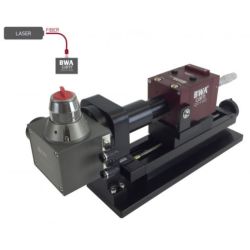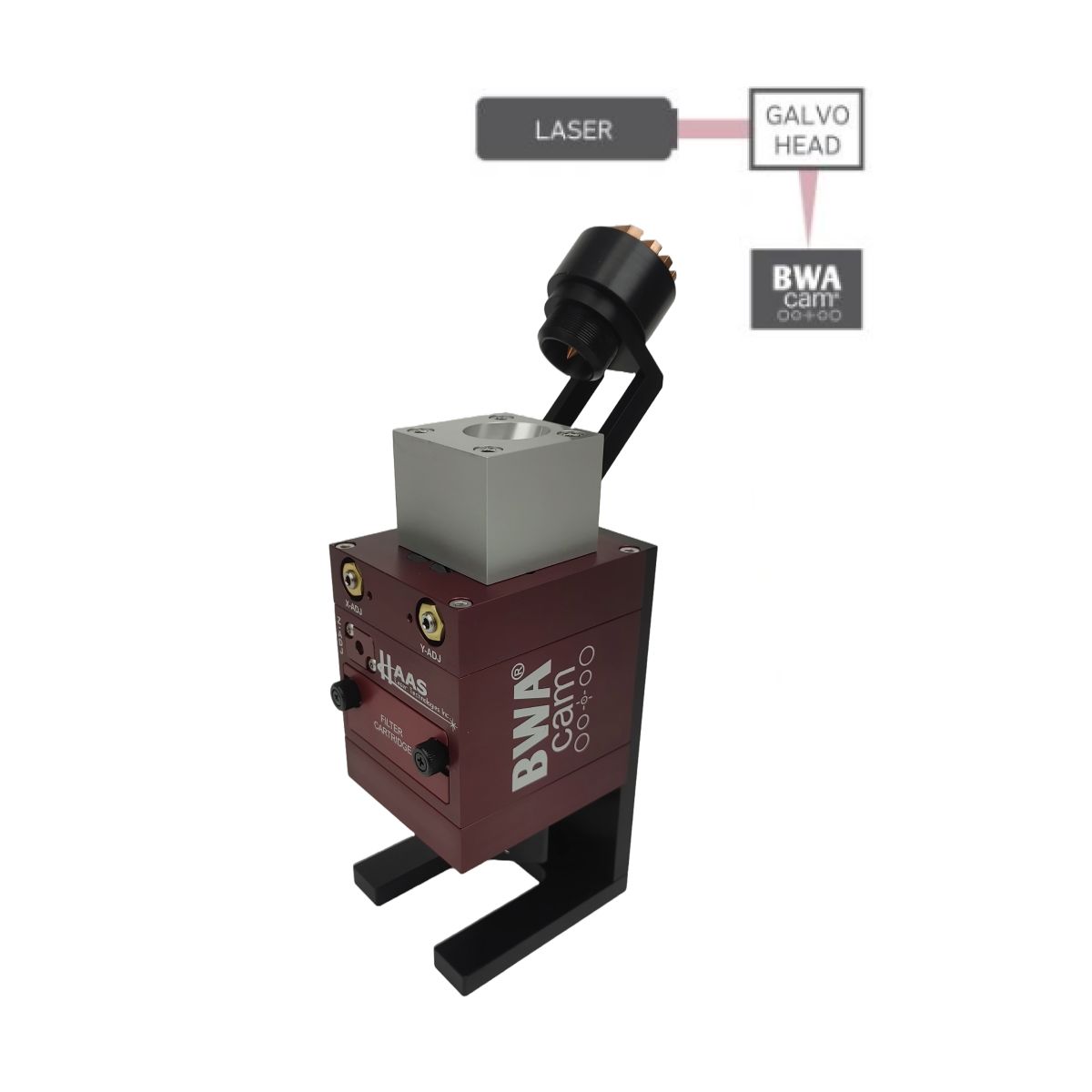BWA-CAM
BWA-CAM®
The BWA-CAM is a precision measurement system for analyzing focused laser beam profiles along the propagation axis. Using a high-resolution camera and automated translation stage, it captures and reconstructs the beam waist, divergence, and M² value with high accuracy. Compatible with a wide range of wavelengths and power levels, the BWA-CAM is ideal for laser alignment, process optimization, and research applications.

-
-
The BWA-CAM® (Beam Waist Analyzer CAMera) is the base module of the Beam Waist Analyzer system. The patented design contains “no moving components” and provides instantaneous 2-D and 3-D measurements, analysis and monitoring through more than one Rayleigh range of the laser beam and all active optical elements.
- Real-Time M² Measurement
Calculate M² without moving optics or scanning components — even for single-pulse lasers. - Real-Time Thermal Lensing Measurement
Instantly measure and record thermal lensing and focus shift without adjusting or moving any physical hardware.
- Polarization Insensitive
Accurate measurement independent of incoming beam polarization. - “One-Button” Calibration
Simplifies system setup and calibration, reducing alignment time. - Wide Power Range
Built-in attenuation handles direct beam powers up to tens of watts; optional solutions support up to 30 kW. - Minimum Measurable Spot Sizes
- 28 µm (with 12MP sensor)
- 48 µm (5MP or 25MP sensor)
- 55 µm (4MP sensor)
- Built-in Optical Density (OD) Attenuation
Integrated -4.0 to -7.0 OD attenuation; external options available for high-power lasers. - Software Auto-Tracking
Automatically tracks the region of interest (ROI) across the beam propagation axis. - Quality Control & Reporting
- All beam quality metrics are continuously monitored
- Automatic ISO-compliant report generation
- Logging and playback for offline analysis
- External interlock control support
- Dual or Single Camera Support
Configure with one or two cameras based on the required measurement range and resolution. - Compact and Modular Design
Designed for easy mechanical integration and compatibility with various wavelengths.
- Real-Time M² Measurement
-
-
The BWA-CAM system supports a range of configuration options to handle different attenuation levels, beam sizes, and power levels. These components are offered separately from the base unit and are built to align with the specific requirements of each application. Because these configurations are not off-the-shelf, they are developed to suit the specifications of your laser setup. The BWA-CAM can be used on its own or combined with the appropriate modules for expanded capability.
BWA-MON® (Fiber Input)

Overview & Specifications
The Haas Laser Technologies BWA-MON Fiber Input Configuration is designed to measure a laser beam directly out of the laser fiber. It provides a means to measure the laser beam together with the fiber. The configuration shown above includes attenuation, focusing optics and mechanics to align and calibrate the system.BWA-MON® (Galvo Input)

Overview & Specifications
While Laser Additive Manufacturing is now capable of providing high quality components, many processes must also comply to DOD and FDA standards. This starts with traceable laser beam measurement and certification before, during and after the manufacturing process The Beam Waist Analyzer Camera (BWA-CAM) for 3D Additive manufacturing enables “real-time” laser beam measurement with “no moveable parts” for analysis and monitoring of high power CW and pulsed lasers. The above 3D Additive Manufacturing modular configuration includes the following technologies:BWA-MON® (Collimated Input)

Overview & Specifications
The Haas Laser Technologies BWA-MON Collimated Input Configuration is designed to measure a laser beam directly out of the laser or directly from a beam expander from a fiber delivered laser. It provides a means to directly measure the laser beam. The configuration shown to the left includes attenuation, focusing optics and mechanics to align and calibrate the system.
BWA-MON® (Post-Focus Input)

Overview & Specifications
The Haas Laser Technologies BWA-MON Post Focus Input Configuration is designed to measure a laser beam directly out of the laser process head. It provides a means to measure the laser beam together with all the optics in the system. The configuration shown to the left includes attenuation, focusing optics and mechanics to align and calibrate the system.
BWA-MON® (Focused Input)

Overview & Specifications
The Haas Laser Technologies BWA-MON Focused Input Configuration is designed to measure a laser beam directly out of the laser. It provides a means to measure the laser beam directly without additional optics. The configuration shown to the left includes attenuation optics and mechanics to align and calibrate the system.
Custom Configuration
Laser systems vary widely by application, and beam monitoring needs to match the specific characteristics of your setup. Haas Laser Technologies provides custom-configured BWA-MON systems built around your laser type, physical constraints, and data requirements.
Our team works directly with yours to configure a reliable, accurate monitoring system that fits into your environment with minimal disruption.
Customization Options:
-
Wavelength Compatibility
Optical components are selected based on your laser source — from UV to IR. -
Mounting and Mechanical Integration
Systems can be designed to mount inline, off-axis, or in tight spaces, depending on your system layout. -
Signal and Data Interface
Output options include Ethernet, USB, and fieldbus protocols. Systems can be configured for integration with PLCs or other machine control systems. -
Software Features
We can include application-specific features such as pass/fail criteria, logging, and custom alert thresholds. -
Cooling and Enclosure Design
Systems can be air- or water-cooled and built to withstand lab or industrial environments.
-
-
File Name Download Link general-ba-bwa-product-brochure.pdfDownload methods-to-measure-laser-beam-metrics-from-low-power-to-30-kilowatts-with-full-iso-11146-manuscript-high-res.pdfDownload whitepaper_lmc_pm-pro_lam_101116.pdfDownload BWA-CAM R5 Brochure R2.pdfDownload BWA-CAM R6 Brochure R2.pdfDownload